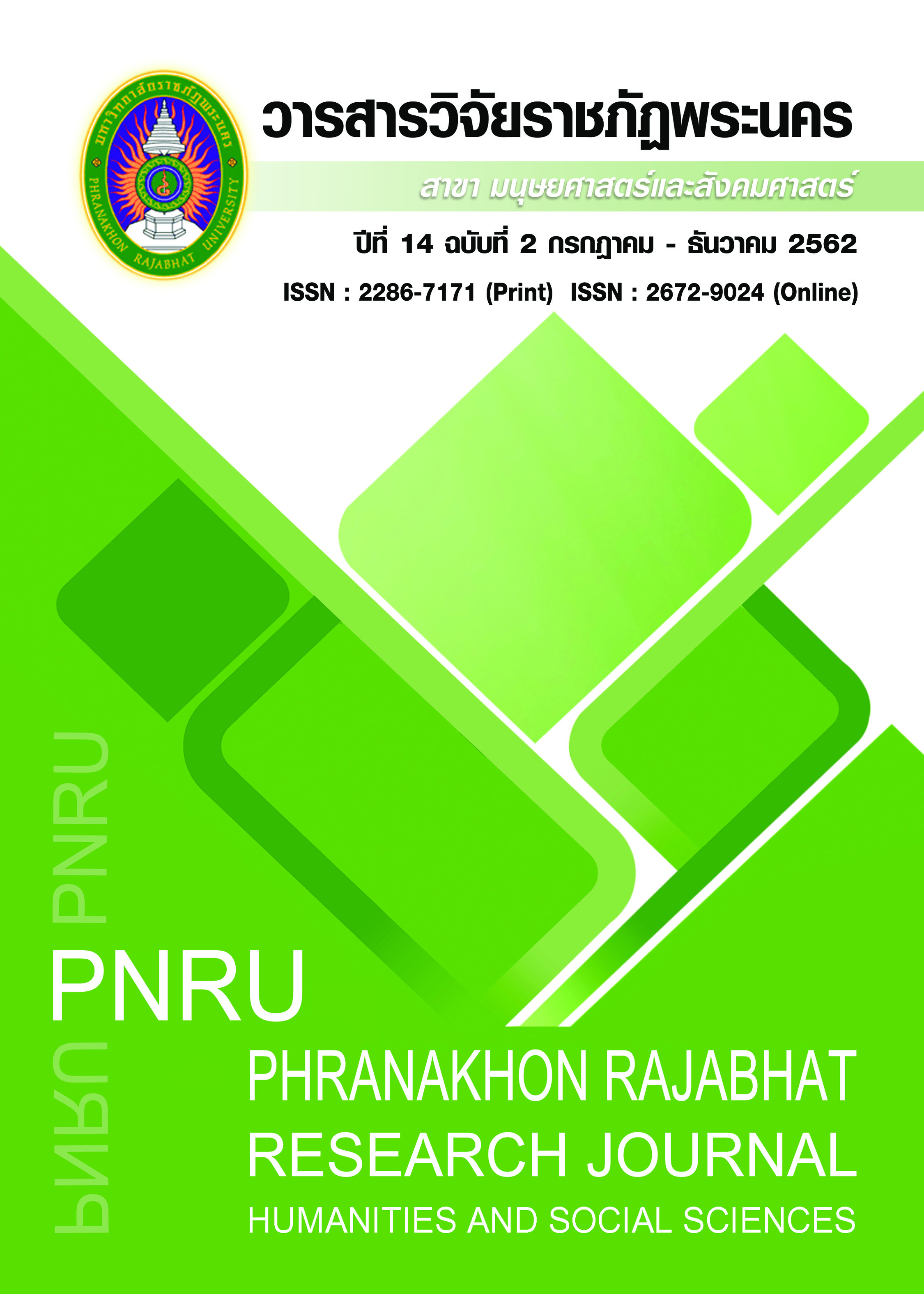SELF-PRESENTATION OF “NET IDOL” THROUGH SYMBOLIC INTERACTION
Main Article Content
Abstract
Social media has a unique feature that allows users to create and produce messages by themselves, and also distributes messages to other users who are connecting in the same online network. Consequently, it causes the phenomenon of a group of famous people on the Internet, also known as “net idol” who has gained popularity with lots of followers and has influenced on others’ cognitive and behavior. The purpose of this article is to study the communication process of a net idol in term of self-presentation that makes them be accepted and be imitated by the members of society, especially the youth. Net idol had communication
process for self-presentation via social media through the symbolic interaction process between net idol and followers, which symbol was changed to a situation while they had the interaction with followers, for making followers’ satisfaction and accepting the self of net idol. The symbolic interaction process between net idol and followers occurred within the same referent frame; as a result, they understood the interchangeable symbol and social world under the same concept.
Article Details
Each publish articles were copyright by Phranakorn Rajabhat University
Any contents which appeared in each articles in the journal were authors personal opinion. It did not relate to Phranakorn Rajabhat University and other instructors in the university. Each authors would take responsibility on their articles. If there are any mistake, the authors will take responsibility themselves
References
Burke, M., & Kraut, R. (2013). Using Facebook after losing a job: differential benefits of strong and weak ties. CSCW 2013, 1419–1430.
Dong, X. (2008). Symbolic interactionism in Sociology of Education textbooks in Mainland China: Coverage, Perspective and Implications. International Education Studies. 1(3), 14-20.
Juntiwasarakij, S. (2016). Towards framing of “net-idol” as cultural influence. Math Journal by the Mathematical Association of Thailand. 61(689), 37-46.
Kaplan, A. M., & Haenlein, M. (2009). The fairyland of second life: virtual social worlds and how to use them. Business horizons. 52(6), 563-572.
Kwon, J., & Nayakankuppam, D. (2015). Strength without elaboration: the role of implicit self-theories in forming and accessing attitudes. Journal of Consumer Research. 42(5), 316-339.
Li, R. (2018). The secret of internet celebrities: a qualitative study of online opinion leaders on Weibo. Proceedings of the 51st Hawaii International Conference (pp. 533-542). System Sciences.
Linetoday. (2018). Line Today. Retrieved 21 June 2018, from https://today.line.me/th/pc/ article/“เน็ตไอดอล” +อาชีพดาวรุ่งพุ่งแรงของเด็ก+ยุค+4+0-MM06kD (in Thai)
Lukacs, G. (2015). The labor of cute: net idols, cute culture, and the digital economy in contemporary Japan. Positions: east asia cultures critique. 23(3), 487-513.
Marwick, A., & Boyd, d. (2011). To see and be seen: celebrity practice on Twitter. Convergence, 17(2), 139–58.
Nidapoll. (2016). Net Idol. Retrieved 21 June 2018, from https://nidapoll.nida.ac.th/index.php? op=polls-detail&id=45 (in Thai)
NewmediaPPTV. (2018). News. Retrieved 21 June 2018, from https://www.pptvhd36.com/ news/ประเด็นร้อน/73740 (in Thai)
Nunes, R.H., Ferreira, J.B., Freitas, A.S., & Ramos, F.S. (2017) The effects of social media opinion leaders’ recommendations on followers’ intention to buy. Review of Business Management. 20(1), 57-73.
Phahulo, S., & Boonnak, P. (2015). Net IDOL. Thinking, 6(5), 12-18.
Reich, S., Schneider, F.M., & Heling, L. (2018). Zero Likes E symbolic interactions and need satisfaction online. Computers in Human Behavior. 80(2018), 97-102.
Roonrakwit, P. (2017). Big five personality and behavioral imitation net idol of adolescents. Veridian E-Journal. 10(2), 157-168. (in Thai)
Rosenberg, R., Burt K., Forehand, R., & Paysnick, A. (2016). Youth self-views, coping with stress, and behavioral/emotional problems: the role of incremental Self-Theory. J Child Fam Stud. 25, 1713–1723.
Scissors, L., Burke, M., & Wengrovitz, M. (2016, February). What’s in a like? attitudes and behaviors around receiving likes on Facebook. CSCW ‘16, 1501-1510.
Sothanasatian, S. (2016). Thritsadikansuesan. 3rd edition. Bangkok: Rongphim Rabiangthong.(in Thai)
Springnewsnetwork. (2017). Spring News. Retrieved 21 June 2018, from https://www. springnews.co.th/view/41558 (in Thai)
Tazghini, S., & Siedlecki, K. L. (2013). A mixed method approach to examining Facebook use and its relationship to self-esteem. Computers in Human Behavior. 29, 827-832.
Thaveephol, R., & Nakpathom, P. (2017). The process of promoting products via social network through ‘net idol’: a study for grounded theory. Panyapiwat Journal. 9(7), 118-130. (in Thai)
Walters, S. (2014). Identification and subjectivity in a Year-3 classroom: using Lacan’s mirror stage to analyse ethnographic data. Ethnography and Education. 9(1), 98-110.
Walther, J.B., Heide B., Kim, S., Westerman, D., & Tom, S. (2008). The role of friends’ appearance and behavior on evaluations of individuals on Facebook: Are we known by the company we keep? Human Communication Research. 34, 28–49.
Wang, Y. (2017). We are Famous on the Internet: A Study of the Chinese Phenomenon of Wanghong (Unpublished master’s thesis). University of Bergen, Bergen.

